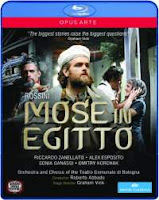Exploring the 2016-2017 Met Opera season ... Decided to look at Verdi's "Nabucco" and "Aida" together. In the process, discovered Rossini's Moses operas and that all four share DNA strands.
"Nabucco" premiered in 1841.
"Abigail" steals crown,
Program notes cite Rossini's "Mose in Egitto" as a major influence on the work.
30 years after "Nabucco," "Aida" marched on the opera stage.
NARRATIVES OF OPPRESSION
THE WORKS
"Nabucco" premiered in 1841.
"Abigail" steals crown,
Thunderstruck king converted;
Lear-light Verdi work.
Program notes cite Rossini's "Mose in Egitto" as a major influence on the work.
"Mose in Egitto" premiered in 1818.
Vick updates Moses
to Syria, migrant crisis.
Sacred score sublime.
Rossini later transformed the work to:
"Moise et Pharaon," which premiered in Paris in 1827.
Revised in French
By Rossini, the music
More meditative.
30 years after "Nabucco," "Aida" marched on the opera stage.
Verdi triangles
Abound. Slave's love conflicts with
Patriotic love.
COMMON TRAITS
Besides being composed by Italians, the works possess other traits in common.
SETTING
They are set in the Middle East. One can argue that Egyptomania courses through these works, culminating in the Cairo Opera House premiere of "Aida."
- Mose in Egitto: Egypt
- Moise et Pharaon: Egypt
- Nabucco: Jerusalem / Babylon
- Aida: Egypt
NARRATIVES OF OPPRESSION
They feature choruses of subjugated populations, something Italian audiences can easily identify with having been subjects of foreign powers. To think there were three Italian Wars of Independence. Third time's the charm.
- Mose in Egitto: Hebrews
- Moise et Pharaon: Hebrews
- Nabucco: Jews / Israelites
- Aida: Nubians
ANTHEMS
They feature anthems, songs that serve to unite a group of people.
Moses and the Hebrews sing a prayer to a God that unites them. The Israelites in "Nabucco" also sing of their plight, another call to God. Aida's farewell to her country is a patriot's sacrifice, all the more moving post-Risorgemento because its unification was hard-fought. Anthems stir audiences' emotions more than romantic duets.
Perhaps because more people can probably say they know what loving a country means than what falling in love with someone means.
Mose in Egitto: "Dal tuo stellato soglio"
Moise et Pharaon: "Dal tuo stellato soglio," en francais.
Nabucco: "Va, pensiero, sull'ali dorate"
Aida: "O Patria Mia"
Moses and the Hebrews sing a prayer to a God that unites them. The Israelites in "Nabucco" also sing of their plight, another call to God. Aida's farewell to her country is a patriot's sacrifice, all the more moving post-Risorgemento because its unification was hard-fought. Anthems stir audiences' emotions more than romantic duets.
Perhaps because more people can probably say they know what loving a country means than what falling in love with someone means.
Mose in Egitto: "Dal tuo stellato soglio"
Moise et Pharaon: "Dal tuo stellato soglio," en francais.
Nabucco: "Va, pensiero, sull'ali dorate"
Aida: "O Patria Mia"
OTHER NOTES
ACTS OF GOD
There are acts of God featured in the 3 earlier works.
- Mose in Egitto: The plagues and the parting of the Red Sea
- Moise et Pharaon: As above.
- Nabucco: Nabucco thunderstruck.
- Aida: There are no acts of God in "Aida" because Verdi concerns himself more with human actions.
VERDI'S MATURATION
Verdi sharpened "Nabucco" to "Aida" in the same way that Rossini refashioned his "Moses" to "Moise." The latter works are also more suited to the French Opera tradition. They made room for ballet.
Verdi refined the love triangle in "Nabucco" between Abigaille, Ismaele, and Fenena to "Aida's" love triangle between Amneris, Radames, and Aida. The latter work has a more solid base. Amid the spectacle, no one loses sight of the smaller pyramid. In "Aida," each of the lead roles are three-dimensional. I dare you to hate Amneris at the end. She merits the mantel of tragic heroine as much as Aida.
To use the buzzword of the moment, I admire Verdi for his grit. He worked until he got better. "Aida" was his best "Nabucco." And to illustrate, listen to the marches from his two works. Which one best suits its narrative? There's a reason why many have walked to the "Aida" march, suitable or not - for me, it was grade school graduation.




No comments:
Post a Comment